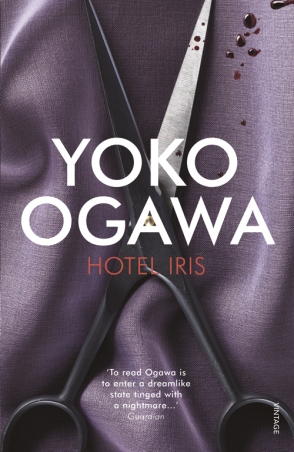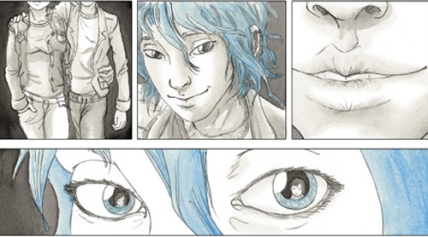In April I read three books: two were pretty dark (a historical Scandinavian murder mystery, and a Japanese novella about pain and pleasure and a strange older man!!) and the other was a depressing but fairly relatable lesbian graphic novel. These were Wolf Winter, Hotel Iris, and Blue is the Warmest Colour, respectively.

Wolf Winter by Cecilia Ekbäck ★★★★★
Dark Scandinavian historical fiction? Plus murder, plus magic, plus a plucky female protagonist that defies 18th century stereotypes? YES PLEASE.
Wolf Winter is written extremely well. Once I got into it I couldn’t stop reading; you feel like everyone in the small community has secrets or an ulterior motive that they’re hiding, and like Maija the protagonist, you want to unearth them. Everything comes to a head at the end of the book; there are a lot of dark elements floating around, but Ekbäck reiterates that the real evil comes from humans, not magic or sinister mountains.
This book has been compared to Hannah Kent’s Burial Rites, and I don’t disagree with this comparison. Both books are set in harsh Scandinavian landscapes (actually, Iceland technically isn’t Scandinavia is it? Oops) hundreds of years ago, have a misunderstood but strong central female character, and murder is the trigger which sets each narrative in motion. They are both skilfully paced and gripping. If you liked Burial Rites, read Wolf Winter, and vice versa! If you haven’t read either: get on it.
Hotel Iris by Yoko Ogawa ★★★★★
Another train-ride-read; Hotel Iris is quite short, and I finished it on the train to Birmingham and back. HOWEVER, I was unaware of how sexually explicit this book is when I took it with me, and would like to take this chance to say it is NOT the best book to read on public transport when sitting next to a stranger! (Thankfully I think the man next to me didn’t notice.)
 I’ve read two other books by Ogawa, The Diving Pool and Revenge, and I think she is an amazing writer. Her stories are dark — and I mean dark — they seem to tap into subconscious desires and fears and everything twisted and spiteful and morbid about being human. Hotel Iris is set in a seasonal seaside town, where a 17 year old girl lives and works with her oppressive mother in their hotel. She is treated like a child and given no free time to socialise with other people her own age. The story begins with an incident at the hotel; an altercation between an older man and a sex-worker. The girl is drawn to the older man and his dominating manner, and enters into a strange relationship on the island off the coast where he lives, where she finds pleasure being hurt, degraded and humiliated.
I’ve read two other books by Ogawa, The Diving Pool and Revenge, and I think she is an amazing writer. Her stories are dark — and I mean dark — they seem to tap into subconscious desires and fears and everything twisted and spiteful and morbid about being human. Hotel Iris is set in a seasonal seaside town, where a 17 year old girl lives and works with her oppressive mother in their hotel. She is treated like a child and given no free time to socialise with other people her own age. The story begins with an incident at the hotel; an altercation between an older man and a sex-worker. The girl is drawn to the older man and his dominating manner, and enters into a strange relationship on the island off the coast where he lives, where she finds pleasure being hurt, degraded and humiliated.
I don’t think Hotel Iris is just a novella about BDSM, though. It is definitely more than problematic erotica (cough, Fifty Shades) because the narrative and mounting tension and intrigue around the older man (who is never actually named, only called the translator; his profession) and his dead wife, and why the protagonist Mari desires him and the extreme sexual relationship they have together, raise so many questions. As a feminist, I found some parts hard to read because the border of consent seems blurred or ambiguous. It’s written in the first person, so Mari would describe the harsh punishment of the translator and extreme discomfort he puts her through, but then say she wanted nothing more. Also the age gap (17 – mid 60s?) seems fraught with problems. Power seems to be a major theme…not just sexual power, but the more subtle forms of manipulation that lie outside of this. I can’t decide what I thought of the ending, and whether Mari won or lost in the grand scheme of things…very ambiguous, and very dark.
I gave it five stars because I haven’t read anything like it before and I think Ogawa is a fantastic and skilled storyteller, and her prose is beautiful, even when describing debased things. She manages to incorporate the extraordinary and disturbing into realism, and the result is unsettling.
Blue is the Warmest Colour by Julie Maroh ★★★☆☆

I’ve been meaning to read this for ages, having seen the film a few years ago and liking it, despite the very-obviously-directed-by-a-man, over-the-top porn-y sex scene. I was intrigued to see how the original graphic novel, written by a lesbian, compared.
I think the book is a lot more tragic in terms of both plot (Emma is reading Clementine’s diaries posthumously from the beginning) and in atmosphere – the colour palette is grey with spots of blue… although I guess this reiterates the title that blue is indeed the warmest colour in the book, ha ha. But, it did make me feel quite down. It’s hopeful in places, but really is just a doomed story of lesbian love, and that has become so much of a trope lately that queer women have started speaking out about it.
I didn’t really like Maroh’s drawing style, so that is why BITWC only gets three stars. I thought it was sketchy in a way that wasn’t my taste, and the facial expressions were often too exaggerated. However, I did think it was a poignant read and an accurate coming-out story. I just wish it was a bit less sorrowful and with less death.
